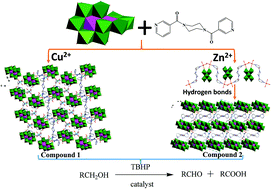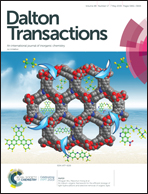Syntheses, structures and catalytic properties of Evans–Showell-type polyoxometalate-based 3D metal–organic complexes constructed from the semi-rigid bis(pyridylformyl)piperazine ligand and transition metals†
Abstract
Herein, two novel Evans–Showell-type polyoxometalate (POM)-based metal–organic complexes, namely, {[Cu(L)(H2O)3][Cu(L)0.5(H2O)][Cu(L)0.5(H2O)4][Co2Mo10H4O38]}·5H2O (1) and [(H2L)0.5]2{[Zn(L)0.5(H2O)4]2[Co2Mo10H4O38]}·2H2O (2) (L = N,N′-bis(3-pyridinecarboxamide)-piperazine), were hydrothermally synthesized using a semi-rigid bis-pyridyl-bis-amide ligand and structurally characterized via single-crystal X-ray diffraction, elemental analysis, IR spectroscopy, powder X-ray diffraction (PXRD) and thermogravimetric analyses (TGA). The single-crystal X-ray diffraction analysis shows that complex 1 is a 3D Evans–Showell-type POM-based metal–organic network. In complex 1, the 1D infinite double chain structure constructed from {{Cu[Co2Mo10H4O38]}4-L} units and the μ4-bridging L ligand are linked by quadrate Cu2L2 loops to form a 2D layer, which is further connected by μ2-bridging L ligands, forming a 3D (2,3,4)-connected metal–organic framework. Complex 2 displays 3D supramolecular networks based on 1D {[Co2Mo10H4O38]–Zn–L}n infinite chains, which are constructed from Evans–Showell-type polyoxoanions and μ2-bridging 3-bpfp ligands (via ligation of pyridyl nitrogen atoms). The different coordination modes of the POM polyanions, bis(pyridylformyl)piperazine ligands and ratios play key roles in the construction of the title complexes. Significantly, the ligand L shows a μ4-bridging coordination mode in complex 1, which is observed for the first time in a POM system. Compounds 1 and 2 represent the first examples of metal–organic complexes based on Evans–Showell-type polyoxoanion and transition metal-bis-pyrazine–bis-amide coordination complexes. The fluorescence properties of the title complexes are reported herein. In addition, the title complexes act as heterogeneous Lewis acid catalysts for the oxidation of benzyl alcohol, and can also be recovered and reused without any significant loss in activity. Significantly, compound 1 with a 3D metal–organic framework showed higher catalytic performance with 99.4% conversion and 98.8% selectivity for benzoic acid at 10 h than compound 2 with 3D supramolecular networks.



 Please wait while we load your content...
Please wait while we load your content...